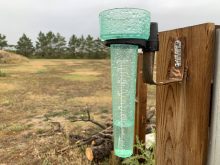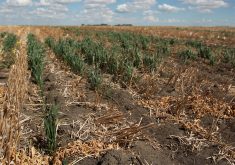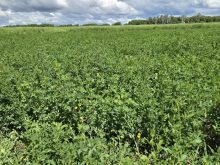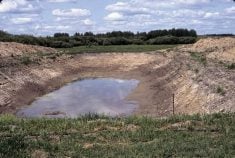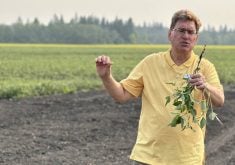Precipitation totals that have declined to 25- to 50-year lows in parts of southern Alberta are causing some farmers to consider their options should dry conditions persist into the spring.
A lack of snow as of early February has added to the ongoing fallout from last summer’s extreme heat waves and drought, said Lynn Jacobson, president of the Alberta Federation of Agriculture.
“I wouldn’t say (this) February is very much different from lots of times,” he said Feb. 16 from his farm near Enchant, Alta. “I mean, we’ve gone into Christmas over that and not had snow…. but most of the time, we don’t go into winter with such depleted moisture, and that’s probably a big factor.”
If the dry weather continues into the spring, there is a worry that “some of the dryland crops probably won’t produce very much yield this year,” he said.
About half of southern Alberta south of the Trans-Canada Highway is experiencing 25-year lows in accumulated precipitation from Feb. 16, 2021, to Feb. 15, 2022, said Ralph Wright, manager of the Alberta Climate Information Service for Alberta Agriculture, Forestry and Rural Economic Development.
There are even 50-year lows along the Milk River Ridge near the Montana border, he said. “I would say areas from Red Deer south are in a moisture deficit and they will benefit greatly from at least near-normal or above-average (precipitation).”
Cracks have appeared in the soil at Jones Hereford Ranches near Balzac north of Calgary, said producer Allen Jones during an interview Feb. 16. “There’s no subsurface moisture and the dugouts are quite low.”
A recent snowfall provided slight relief from the sight of brown fields stripped of snow by warm chinook winds and milder temperatures. However, if the overall pattern of low precipitation continues, Jones may have to eventually sell some of his herd due to shortages of feed and water.
“We don’t know — it’s because it’s such a moving target. There’s so much variation in it, but if we don’t have grass, we’re going to have to start selling them off for sure.”
Wright said conditions in Alberta have generally been wetter north of Red Deer, reaching close to average or even well above in several areas. However, he noted that southern Alberta typically tends to get more moisture from Jan. 1 to the end of June than other growing areas in Alberta.
Despite this trend, the province has experienced “an exceedingly dry period” extending back five to seven years depending on the location, with last year being the worst. However, such periods generally haven’t lasted more than five or six years during the past seven decades, he added.

The hope is that the coming spring will finally kick the dry pattern in southern Alberta “out of the skies and get into a nice wetter pattern,” like what happened north of Red Deer from last fall to this winter.
Although “the whole province (typically) has this very dry January-February-March period,” southern Alberta usually also has a dry season that begins in July and extends until the end of March, said Wright.
Of course, climate change is throwing a potential wildcard into the mix. There was a link between the record-breaking hot weather that hit Western Canada in 2021 and the ongoing megadrought that has dominated the western United States, said John Pomeroy, Canada Research Chair in Water Resources and Climate Change at the University of Saskatchewan.
Wright said few people could have foretold the wildfires and heat waves that hit producers in British Columbia last summer would be followed by unprecedented flooding in November. He cautioned he can’t predict what will happen in the next couple months for southern Alberta farmers.
“I think a lot of them would be happy with 50 millimetres of rain, or two feet of snow would be absolutely wonderful.”




